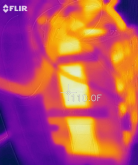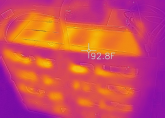svetz
Works in theory! Practice? That's something else
Time for a discharge test of my 400Wh test pack! Yep, it’s housed in that old Peak Jump Start. It was dead in the garage collecting dust… but 20 new 32700 cells in a 4s5p configuration replaced the old 18 Ah (216 Wh) LA battery and has brought it to life again. It sure is lighter with Lithium. Haven't used it to jump cars (not sure my soldering would hold up), primarily it's to run the inverter to power stuff away from the house.
20 cells x 3.2v x 6.5 Ah = 416Wh, although at 90% that’s ~374Wh. At the time I purchased the LiitoKala cells, the price was $176/kWh. Before @robaroni I'd only heard bad things about them, but on paper they looked good so I figured what the heck. Basically, this just was a learning experience, that I got something useful out of it is a plus. Been learning a lot from Will's site, so not sure what I'll do next.
Using the Jump Start was an afterthought (originally I was going to scavenge it for parts), as you can see it already had a DC switch, LED gauge, LED lights, USB port, a handy case, and handy alligator clips. But after I took it apart I saw I could just re-purpose it rather than scavenging it for parts.
It’s been resting for about 2 weeks, on disassembly the cells were slightly discharged but perfectly balanced.
With the back taken off, you can see the “lift-out” basket the original lead-acid battery came in, the 32x70mm cells fit the height with enough room to run the cables, BMS on top. Ah shoot, I meant to use the label maker to put on a label on that big red wire that said “wire” for @eddie1261! Next time buddy!


~200W load and go... and wait and wait and wait... Getting down to the end… and got 362Wh before the inverter cut out (the inverter cuts out before the BMS, it’s ancient).
So, draining at .5C it doesn’t get very warm, this is about 1/3 the way through; I can see it’s firing on all cylinders…
Warms up more near the end but still not very hot… side view

Next up recharging! Takes forever as I'm using the original junk charger that was in it. It was slow before, and now the battery capacity is twice the size. Turned out the AC adapter had the right voltage, so I just snipped it off the Peak's circuit board and soldered it to the BMS.
Other similar projects & Tips
20 cells x 3.2v x 6.5 Ah = 416Wh, although at 90% that’s ~374Wh. At the time I purchased the LiitoKala cells, the price was $176/kWh. Before @robaroni I'd only heard bad things about them, but on paper they looked good so I figured what the heck. Basically, this just was a learning experience, that I got something useful out of it is a plus. Been learning a lot from Will's site, so not sure what I'll do next.
Using the Jump Start was an afterthought (originally I was going to scavenge it for parts), as you can see it already had a DC switch, LED gauge, LED lights, USB port, a handy case, and handy alligator clips. But after I took it apart I saw I could just re-purpose it rather than scavenging it for parts.
It’s been resting for about 2 weeks, on disassembly the cells were slightly discharged but perfectly balanced.
With the back taken off, you can see the “lift-out” basket the original lead-acid battery came in, the 32x70mm cells fit the height with enough room to run the cables, BMS on top. Ah shoot, I meant to use the label maker to put on a label on that big red wire that said “wire” for @eddie1261! Next time buddy!


~200W load and go... and wait and wait and wait... Getting down to the end… and got 362Wh before the inverter cut out (the inverter cuts out before the BMS, it’s ancient).
So, draining at .5C it doesn’t get very warm, this is about 1/3 the way through; I can see it’s firing on all cylinders…
Warms up more near the end but still not very hot… side view

Next up recharging! Takes forever as I'm using the original junk charger that was in it. It was slow before, and now the battery capacity is twice the size. Turned out the AC adapter had the right voltage, so I just snipped it off the Peak's circuit board and soldered it to the BMS.
Other similar projects & Tips
Last edited:





